A VERY GOOD GARDEN NOW
Finally
A recent blog post of mine was titled and about some of the reasons it was “My Worst Garden Ever.” From comments and emails, I learned that such was the case generally in this part of the world. That was then.
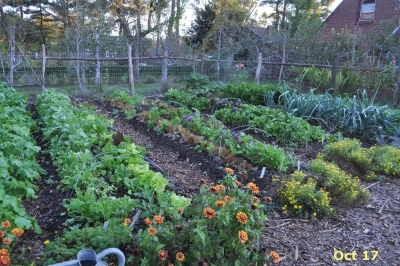 Recently, as I opened and walked through the gate into my vegetable garden, I thought, hmmm, things are looking pretty spiffy in the garden. Even a seasoned gardener friend remarked, “There’s so much green!” And that green is not from weeds, but from neat rows of napa cabbages, large heads of lettuce in various shapes and shades of green, and dark green rows of arugula and mustard. Leafy tops of Watermelon radishes (the name from the look of the sliced roots, not any affinity in flavor) and sweet Hakurei turnips perched above swelling roots.
Recently, as I opened and walked through the gate into my vegetable garden, I thought, hmmm, things are looking pretty spiffy in the garden. Even a seasoned gardener friend remarked, “There’s so much green!” And that green is not from weeds, but from neat rows of napa cabbages, large heads of lettuce in various shapes and shades of green, and dark green rows of arugula and mustard. Leafy tops of Watermelon radishes (the name from the look of the sliced roots, not any affinity in flavor) and sweet Hakurei turnips perched above swelling roots.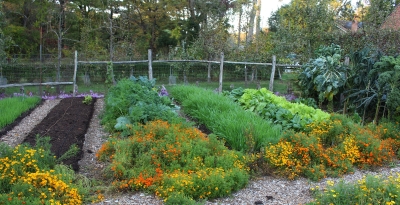
The Autumn Garden
Just as there were reasons for my worst garden ever, their are reasons for the present good show. This show started with harvesting summer’s spent corn, soybeans, green beans, and tomatoes, carefully removing the above ground of the plants along with any major roots, all helped along with my hori-hori knife. Weeds were likewise removed.
That done, I marked with a string and then some rice flour or limestone each edge of a bed along each of which I laid a ten foot metal 2 by 4. Each 2 by 4 stood on its narrow side, held upright by two metal U-clips. The purpose of this temporary border is to keep everything tidy.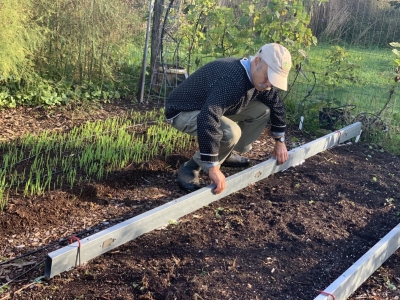 Into each bed went compost, enough, when spread and flattened, to leave a depth of one-inch. That done, the metal 2 by 4s are moved to the next bed.
Into each bed went compost, enough, when spread and flattened, to leave a depth of one-inch. That done, the metal 2 by 4s are moved to the next bed.

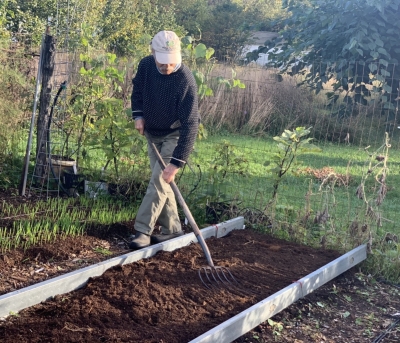 I had transplants of napa cabbage, cauliflower, lettuce, and cabbage ready to plant in prepared ground. I had blamed my “worst garden ever” on, among other things, poor potting soil, a newer, experimental, home made mix; these recent transplants looked fine, having been grown in the standard, home made mix that has stood me well over the years. That is, except for the cabbages, which had been in the newer, experimental mix. They went into the ground stunted and looks like they still won’t have time to head up.
I had transplants of napa cabbage, cauliflower, lettuce, and cabbage ready to plant in prepared ground. I had blamed my “worst garden ever” on, among other things, poor potting soil, a newer, experimental, home made mix; these recent transplants looked fine, having been grown in the standard, home made mix that has stood me well over the years. That is, except for the cabbages, which had been in the newer, experimental mix. They went into the ground stunted and looks like they still won’t have time to head up.
As for the turnips, radishes, arugula, and mustard, I sowed their seeds directly in the beds about six weeks ago. The same goes for yet more lettuces for, instead of crisp heads, “cut and come again” harvest.
Weed Patrol
Paths between beds can become home to many weeds in the vegetable garden. In the past, my usual approach to these weeds had been to suffocate them beneath arborist wood chips laid down every year or two. If weeds got really out of hand there, I’d lay down some paper and top that with wood chips. Gray Rosin Paper, available at building supply stores comes in three foot wide rolls; cutting each roll in half let me conveniently unroll the paper up my 18 inch wide paths.
Still, a weed problem remains — in the interface between the edge of a path and the edge of a bed. These small weeds would be easy enough to hoe in a bed, but hoeing mulch doesn’t work so well. I went ahead and hoed anyway. The mulch layer has been almost digested away, and I’ll just continue to hoe it periodically. If done regularly with the right hoe, such as the winged weeder or wire hoe, it takes little time.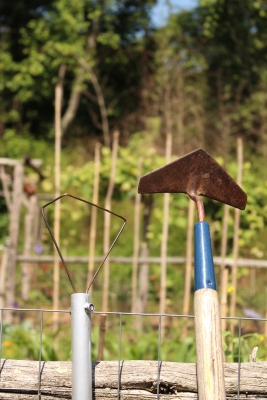 It goes without saying that I, of course, also kept any weeds within the beds in check either with a hoe or hand pulling. They are rarely a problem since the compost, laid down as mulch, has few viable weeds seeds.
It goes without saying that I, of course, also kept any weeds within the beds in check either with a hoe or hand pulling. They are rarely a problem since the compost, laid down as mulch, has few viable weeds seeds.
Lepidopterae
Few insects have caused problems in my vegetable gardens. A notable exception is cabbage worms, which actually are caterpillars and represent a few different species. They typically build up steam here through September. Left to their own devices, they’ll riddle cabbage, kale, and Brussels sprouts with holes, enough to weaken plants so they don’t head up, if that’s the plants’ goal, or, in the case of kale, grow sufficient leaves.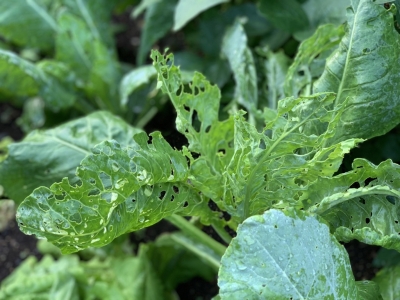 The caterpillars will feed voraciously within heads of napa cabbages, resulting in gooey heads (the cabbages, not the caterpillars).
The caterpillars will feed voraciously within heads of napa cabbages, resulting in gooey heads (the cabbages, not the caterpillars).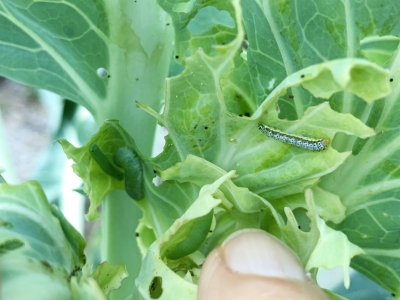
Dealing with the cabbage worms is easy: Bacillus thuringiensis aka Bt, and sold commercially under such names as Thuricide or Dipel. This is a naturally occurring bacterium found in soils, on leaf surfaces, and in the gut of various caterpillars, among other places. The subspecies kurstaki, Btk, is toxic to lepidopterous caterpillars and is the active ingredient of the commercial products. The bacteria are nontoxic to humans and most other species.
I inspect my cabbage family plants periodically, tolerating a certain amount of damage or infestation but spraying if it gets too severe. The caterpillars have been particularly numerous this season but judicious spraying has kept them in check. I do limit the spraying as much as possible to avoid buildup of insect resistance to the bacteria.
So things do look good in the vegetable gardens. Beyond the fences of my vegetable gardens still lie reminiscences of this summer’s “worst garden” in the form of numerous weeds, especially thistles. I’ll tend to them once I finish ground preparation for next spring with the vegetable gardens.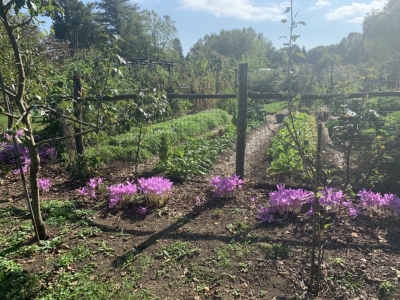




you’re an inspiration to us all, Lee
(I blush)